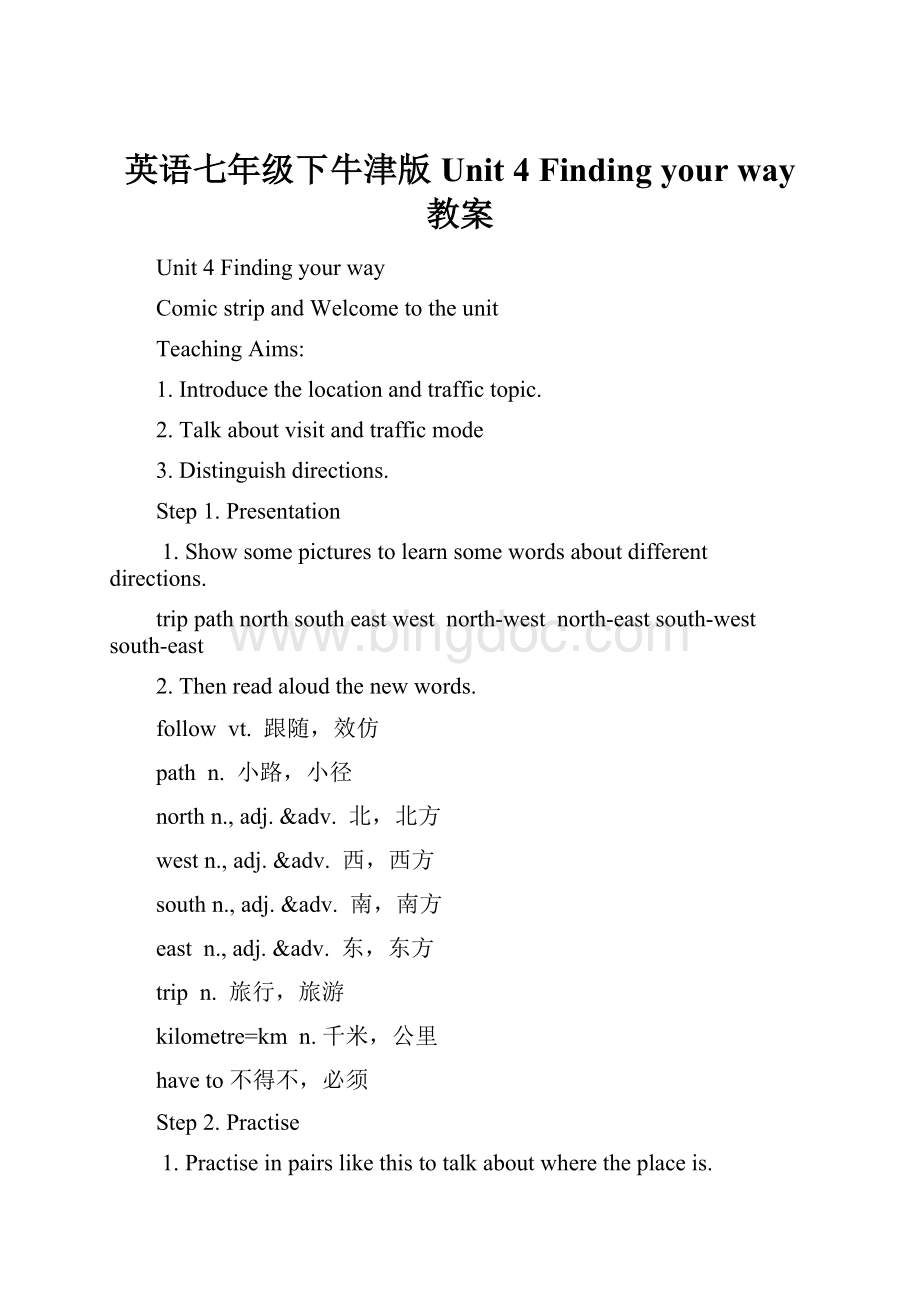英语七年级下牛津版Unit 4 Finding your way 教案.docx
《英语七年级下牛津版Unit 4 Finding your way 教案.docx》由会员分享,可在线阅读,更多相关《英语七年级下牛津版Unit 4 Finding your way 教案.docx(21页珍藏版)》请在冰点文库上搜索。

英语七年级下牛津版Unit4Findingyourway教案
Unit4Findingyourway
ComicstripandWelcometotheunit
TeachingAims:
1.Introducethelocationandtraffictopic.
2.Talkaboutvisitandtrafficmode
3.Distinguishdirections.
Step1.Presentation
1.Showsomepicturestolearnsomewordsaboutdifferentdirections.
trippathnorthsoutheastwestnorth-westnorth-eastsouth-westsouth-east
2.Thenreadaloudthenewwords.
followvt.跟随,效仿
pathn.小路,小径
northn.,adj.&adv.北,北方
westn.,adj.&adv.西,西方
southn.,adj.&adv.南,南方
eastn.,adj.&adv.东,东方
tripn.旅行,旅游
kilometre=kmn.千米,公里
haveto不得不,必须
Step2.Practise
1.Practiseinpairslikethistotalkaboutwheretheplaceis.
A:
Whereis…?
(旅游)?
B:
It’snorth/south/east/westof…
2.AskstudentstocompletePartAonPage43.
Step3.Presentation
PresentsomepicturesforSstolearnhowtogetthere.ThenaskSstomakesomedialogues.
Step4.Listenandanswer
1.ListentopartBandanswerthefollowingquestion.
Wherearetheygoingfortheirclasstrip?
Whereisthezoo?
Howwilltheygetthere?
2.Readaftertherecorder.
3.Practiceinpairs.
4.Actitout.
5.Maketheirowndialogue.
Step5.Learntheconversation
1.Listentothetapeandask:
1)WhereareHoboandEddiestanding?
2)WhatdoesHoboaskEddietodointhepicture?
3)Dotheyhavetogoupthehillagain?
4)DoesHoboreallyknowtheway?
Keys:
1.Theyareonthetopofthehill.
2.Heaskshimtogodownthehill.
3.Yes,theydo.
4.No,hedoesn’t.
2.Actouttheconversation
Step6.Explanation
1.方位介词的用法小结
benorth/south/west/eastof...在……北部/南部/西部/东部
benorth-east/south-westof...在……东北部/西南部
benorth-west/south-eastof...在……西北部/东南部
Aisinthe...ofB(A在B内部……方位)
Aisonthe…ofB(A与B接壤)
Aistothe…ofB(A与B不接壤)
2.beafraidofdoingsth./ofsth.害怕做某事
beafraidthat…
I’mafraid…
Step7.Exercises
Translation.
1.别这么肯定。
我们请老师帮帮忙吧。
Don’tbesosure.Let’sasktheteacherforhelp.
2.别害怕,我们会帮你的。
Don’tbeafraid.Wewillhelpyou.
3.有些人害怕狗。
Somepeopleareafraidofdogs.
4.玄武湖离我们学校不远,就在学校北边。
Xuanwulakeisnotfarawayfromourschool.Itisjustnorthoftheschool.
5.跟我走吧,我认识去公交车站的路。
Followme.Iknowthewaytothebusstop.
Step8Homework:
1.Readthetextbookandlearnthenewwordsandphrasesbyheart.
2.Dotheexercisesintheworkbook.
3.Previewthenewwordsofreadingpart.
ReadingI
TeachingAims:
1.Learnsomenewwordsabouttalkingaboutdifferentanimals.
2.Practisereadingskillsbylearningthetriptothezoo
Step1.Presentation
Presentthenewwordsandreadthemaloud.
everybodystraightonbambooalldaylongalongroadkingrememberthatdangeroussoundforestfunnylaughgiraffequiteneck
leaf(leaves)north-eastbridgecross
Step2.Warmingup
AskSsthequestions:
Whereisthezooinourcity?
Howcanyougettothezoofromourschool?
Whatanimalsdoyoulike?
Telluswhy?
Showsomepicturesofpandas,lions,birds,monkeys,giraffes,elephants.
Step3.Reading
1.Listentotextandanswerthequestions:
1)Howmanykindsofanimalsarethereinthearticle?
Six.
2)Whatarethey?
Theyarepandas,lions,birds,monkeys,giraffesandelephants.
2.ReadthearticleagainandcompletepartB1onpage45.
3.ReadaloudthearticleandputTorFintheblanks.
ThestudentsstarttheirvisitfromtheNorthGate._____
Pandasdonotliketoliedownalldaylong.______
Visitorscannotgonearthelions.______
Thebirdsinthezooareveryquiet.______
Monkeysarecleverandfunny.______
Tothenorth-eastofthegiraffesthereisahill.______
Keys:
FFTFTF
4.DiscussandfillthetableofB3onPage46.
4.Readaloudthetexttogether.
5.CompleteB4onpage46.
6.Checktheanswers
7.ActB4out.
Step4.Homework
1.Readaloudthearticleandunderlinethedifficultparts.
2.Rememberthenewwordsinthislesson.
ReadingII
TeachingAims:
1.Learnthelanguagepointsinthisarticle.
2.LearntotalkaboutSs’owntrips.
Step1.Revision
Retellthetextaccordingtothepicturesandthekeywords.
Step2.Explanations
1.Gostraighton,youwillfindthePandaHouse.
gostraighton径直走
2.Theyliketoeatbambooandliedownalldaylong.
liedown躺下
alldaylong整天
e.g.Thepandasliedownalldaylong.
3.Walkalongtheroad.沿着这条路走。
along“沿着,顺着”是个介词。
4.Thelionsarethekingoftheanimalworld.
thekingof……的国王
5.Rememberthattheyaredangerous.
remember作及物动词,意为“记得,记住”,后可直接跟名词(短语)、代词或that从句。
例如:
Idon’trememberhisphonenumber.
我不记得他的电话号码。
ThisisLisa.Doyourememberher?
这是丽莎。
你记得她吗?
Irememberthatyouhavelearned
Chinesekungfubefore.
我记得你以前学过中国功夫。
remember后既可接动词不定式作宾语,也可以接v-ing形式作宾语,但二者在意义上有区别:
remembertodosth.意为“记得去做某事”,即事情未做;rememberdoingsth.意为“记得做过某事”,即事情已做。
例如:
Remembertolockthedoor.别忘了锁门。
Herememberedlockingthedoor.他记得他把门锁上了。
dangerous作形容词,意为“危险的”,可位于名词之前作定语,也可放在be动词之后作表语。
bedangerousforsb.todosth.意为“对某人来说做某事是危险的”。
例如:
Ithinkboxingisadangeroussport.
我认为拳击是一项危险的运动。
Flyingplanesisdangerous.
驾驶飞机是危险的。
It’sdangerousforchildrentoswiminthisriver.
对孩子们来说,在这条河里游泳是危险的。
6.Birdsmakebeautifulsoundswhentheysing.
makebeautifulsounds发出美妙的声音
7.Monkeysarecleverandfunny.
funn.“乐趣”,为不可数名词
funadj.“有趣的”
funnyadj.“好笑的,滑稽的”
e.g.Wehavelotsoffuntogether.
Thebookisfun.
Heisafunnyperson.
8.Monkeysjumparoundandmakepeoplelaugh.
jumparound/into/outof跳来跳去/跳进/跳出
makesb.dosth.
make为使役动词,后面用省略to的不定式。
相同用法的词还有let/have。
make…+adj.使……怎么样
e.g.Thefilmmakesuslaugh.Itmakesushappy.
9.Crossthebridge,andyou’llseetheelephants.
cross作及物动词,意为“穿过,横过”。
例如:
Crossthebridge,andyouwillseeapostofficeonyourright.
过了桥,你就会看见在你的右边有一个邮局。
Areyousurewecancrosstheriversafely?
你确信我们可以安全地过河吗?
Summary:
通过对课文的学习,我们总结一下指路语言:
Gostraighton,andyou’llfindthePandaHouse.
Walkalongtheroad.TothenorthofthePandaHouse,you’llfindthelions.
Turnleft,andtothewestoftheLions’Area,you’llfindtheWorldofBirds.
North-eastofthegiraffesthere’sabridge.
Crossthebridge,andyou’llseetheelephants.
Step3.Exercises
Step4.Interview
Youareaninterviewer.YouwanttointerviewMillieaboutthetriptoSunshineZoo.Workinpairs,trytoaskatleastfivequestionsabouttheshow.
Step5.Homework
1.Recitethisarticle.
2.Rememberthelanguagepointsinthislesson.
Grammar
TeachingAims:
1.Introducetheusageofa,anandthe.
2.Learnsomeprepositionsofplace.
Step1.Presentation
Enjoyapictureandpresentthenewword‘cage’.
Step2.Warmingup
Enjoymorepicturesandtalkabouttheusageofa,anandthe.
Step3.Explanation
不定冠词a/an的用法
1.第一次提到某人或某物时。
Ihaveabook.
2.泛指某一类的人或物。
Apandaisverylovely.
判断一个单词用a还是用an,是根据其读音,而不是根据其首字母。
以元音音素开头的词前用“an”,以辅音音素开头的词前“a”。
如:
anhour,anapple,anelephant,ausefulbook等。
定冠词the的用法
1.指上文提到过的人或物。
如:
Lucyboughtanewbike,thebikeisgreen.
2.世界上独一无二的事物。
如:
thesunthemoon
3.谈到彼此都知道的人或事物。
如:
Openthedoor,please.
4.序数词和形容词最高级前。
如:
Sheisalwaysthefirsttogettoschool.
5.乐器名词前用。
playthepianoplaytheviolin
6.定冠词与形容词连用表示一类人,加在姓氏前面表示一家人。
therichtheyoung
7.某些专用名词和习惯用语中用定冠词。
theGreatwallbytheway
不用冠词的情况
1名词前已经有指示代词(this,that,these,those)、形容词性物主代词(my,his,our…)或名词所有格等限定词。
2.表示语言、学科、三餐、球类运动、棋类运动的名词前。
3.表示星期、月份、季节、某些节日的名词前。
4.表示人名、国名、称呼语或头衔等专有名词前。
5.某些固定短语中。
bybike,bybus,atfirst,atwork,onfoot,gotoschool,gotobed,等。
Step4.Doingexercises
1.CompletethedialogueonPage47.
Notes:
across作介词,既可表示静态的位置关系,意为“在……对面”,也可表示动态的移动方向,通常和一些表示“移动”的动词搭配使用,意为“从……穿过”。
例如:
Thehotelisjustacrosstheflowershop.
旅馆就在花店的对面。
Itwilltakethemtwoweekstowalkacrossthedesert.
徒步穿过这片沙漠将会花费他们两周的时间。
2.Domoreexercises.
在必要的地方用a,an,the填空。
1.WhereisPeter?
Heisn’tat___school.×
2.Thereis___orangeinthefridge.an
3.____pencilonthedeskbelongstoSandy.The
4.Ihave__newbike.Iclean___bikeeveryday.a,the
5.Dadoftengoesfishingin____summer.×
6.A:
CanIhelpyou?
B:
I’mlookingfor___pairofshoes.a
7.Thestudentsoftengotoschoolby______bike.×
8.Whoisgoodatplaying______footballinyourclass?
×
9._____boyinaredcoatismycousin.The
10.Iliveon____thirdfloor.the
11.Thereis___“h”,___“o”,___“u”intheword“hour”.an,an,a
12.Simonlikestoplay____pianobuthedoesn’tliketoplay___basketball.the,×
13.Beijingis____capitalofChina.the
Step5.Presentation
1.Usesomepicturestopresentthenewwordaboutprepositionsofplace.
2.Readaboutthenewwords.
Step6.Explanation
over在……的正上方
under在……的正下方
above在……的上方(表面
不接触)
below在……的下方
on在……的上面(表面接触)
Step7.Exercises
1.Dotheexercisesonpage48.
2.Checktheanswers.
3.Domoreexercises.
填入适当的介词使句子通顺。
1.Thefootballis______thedoor,soIcan’tseeit.behind
2.Don’tstand__________us,orwecan’tseethefilmclearly.infrontof
3.Thereisanelectricfan_____thedesk.on
4.Look!
Yourrubberis_____thechair.Pickitup.under
5.Themoonisnow_____thetrees.above
6.Eddiedoesn’twanttolive__thepalace.in
7.Stephenischattingwithhisfriends___thebalcony.on
8.LiMingismyneighbour.Hishouseis_____________mine.beside/nextto
Step8.Homework
1.Rememberthenewwordsinthislesson.
2.Finihstheexercisesintheworkbook.
Integratedskills
TeachingAims:
1.Learnsomewordsaboutshowingtheway.
2.Practiselisteningskillsbylisteningtoatext.
Step1.Presentation
1.Presentthenewwords.
turningn.转弯处
treasuren.宝藏
trafficn.交通,来往车辆
trafficlightsn.交通灯
shouldmodalv.应该,应当
crossingn